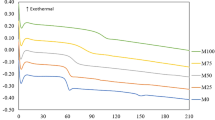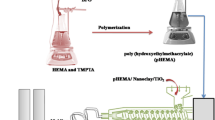Abstract
Polymethylmethacrylate (PMMA) and polysulphone (PSu) are biocompatible polymers and are used widely for biomedical applications. In this study, a blend membrane of PMMA/PSu was fabricated using methylene bisacrylamide (MBA) as the blending agent and its properties were studied. Subsequently, a composite membrane consisting of β-tricalcium phosphate (β-TCP) filler dispersed in a polymer matrix of PMMA/PSu was fabricated and evaluated for application as an orthopaedic prosthetic material. Fourier Transform Infrared Spectroscopy spectra of the blend confirmed the interaction of PMMA and PSu with the blending agent MBA. The X-ray diffraction analysis showed that PMMA/PSu membranes exhibited a higher degree of crystallinity when compared with that of the individual polymers. The thermal properties of the samples studied by thermogravimetric analysis showed an increase in the thermal stability of the PMMA/PSu when compared with individual PMMA and PSu membranes. The morphology of the composite samples analysed through SEM showed that the fillers were widely distributed and agglomerated at certain places. The tensile strength of the PMMA/PSu/β-TCP was found to be inferior to that of PMMA/β-TCP although much superior to that of PSu/β-TCP composite membranes. Hardness testing performed using durometer hardness tester (Shore D) showed that the PMMA/PSu/β-TCP samples exhibited higher hardness than the composites having individual PMMA and PSu matrices. Analysis of the optical properties of the polymer membranes suggested good blend formation between PMMA and PSu. The in vitro bioactivity study suggested that the density of the calcium phosphate layer formed on the surface of PMMA/PSu/β-TCP was much higher than that of composites made of either PMMA or PSu matrix. The results of the study showed that the blended composite membranes exhibited favourable properties for biomedical applications such as for orthopaedic prostheses.






Similar content being viewed by others
References
Frazer RQ, Byron RT, Osborne PB, West KP (2005) J Long Term Eff Med Implants 15(6):629
Park JB (1992) Ann Biomed Eng 20(6):583
Arias JL, Carrillo AN, Arias JI, Escobar C, Bodero M, David M, Fernández MS (2004) J Mater Chem 14:2154
Nakashima A, Ogata S, Doi S, Yamahira M, Naraki S, Takasugi N, Ohmoto T, Ito T, Masaki T, Yorioka N (2006) Clin Exp Nephrol 10(3):210
Lu J (2004) Orthopedic bone cements. In: Poitout DG (ed) Biomechanics and biomaterials in orthopaedics, 1st edn. Springer, Singapore, p 86
Tsukeoka T, Suzuki M, Ohtsuki C, Sugino A, Tsuneizumi Y, Miyagi J, Kuramoto K, Moriya H (2006) Biomaterials 27(21):3897
Harper EJ (1998) Proc Inst Mech Eng H 212(2):113
Kokubo T (2005) Mater Sci Eng C 25:97
Moszner N, Fischer UK, Angermann J, Rheinberger V (2006) Dent Materials 22:1157
Kratz K, Lapp A, Eimer W, Hellweg T (2002) Colloids Surf A Physicochem Eng Asp 197:55
Deimede VA, Fragou KV, Koulouri EG, Kallitsis JK, Voyiatzis GA (2000) Polymer 41:9095
Lemons JE (1996) Bone 19(Suppl 1):121S
Sunder M, Babu NR, Victor SP, Kumar KR, Kumar TSS (2005) Trends Biomater Artif Organs 18(2):213
Kokubo T, Kushitani H, Sakka S, Kitsugi T, Yamamuto T (1990) J Biomed Mater Res 24:721
Helebrant A, Jonášová L, Šanda L (2002) Ceram Silik 46(1):9
Bayraktar D, Tas AC (2000) Turk J Med Sci 30:235
Li XW, Yasuda HY, Umakoshi Y (2006) J Mater Sci Mater Med 17:73
Krause S (1986) Pure Appl Chem 58(12):1553
Rajulu AV, Reddy RL, Raghavendra SM, Ahmed SA (1999) Eur Polym J 35:1183
Cascone MG, Polacco G, Lazzeri L, Barbani N (1997) J Appl Polym Sci 66:2089
Rajulu AV, Devi LG, Rao GB (2003) J Appl Polym Sci 89:2970. doi:10.1002/app.12399
Stein RS, Keane JJ, Norris FH, Bettelheim FA, Wilson PR (1959) Ann N Y Acad Sci 83:37. doi:10.1111/j.1749-6632.1960.tb40882.x
Pattanayak DK, Divya P, Upadhyay S, Prasad RC, Rao BT, Mohan TRR (2005) Trends Biomater Artif Organs 18(2):87
Tardei C, Grigore F, Pasuk I, Stoleriu S (2006) J Optoelectron Adv Mater 8(2):568
Mano JF, Sousa RA, Boesel LF, Neves NM (2004) Compos Sci Technol 64:789
Wang M, Yue CY, Chua B (2001) J Mater Sci Mater Med 12:821
Wang M (2003) Biomaterials 24:2133
Acknowledgement
The authors would like to acknowledge the National Doctoral Fellowship of All India Council for Technical Education (AICTE), New Delhi, India vide their letter no. 200-64/FIN/04/05/116, Dated 08.10.2010.
Author information
Authors and Affiliations
Corresponding author
Rights and permissions
About this article
Cite this article
Bhat, K.A., Rajangam, P. & Dharmalingam, S. Fabrication and characterization of polymethylmethacrylate/polysulphone/β-tricalcium phosphate composite for orthopaedic applications. J Mater Sci 47, 1038–1045 (2012). https://doi.org/10.1007/s10853-011-5892-y
Received:
Accepted:
Published:
Issue Date:
DOI: https://doi.org/10.1007/s10853-011-5892-y




